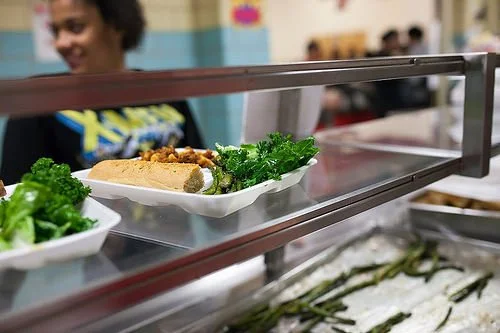Vermont universal school meals bill looks to boost local farm food
Photo courtesy of the USDA
As lawmakers aim to make universal school meals a permanent measure, they are also looking to make sure more of those meals are made with local food.
The state would be able to do that by combining a local food grant program for schools created in 2021 with the proposed universal meals fund. The Agency of Education already distributes those grants to schools based on the percent of Vermont-produced foods they use in their meals, but current law only allows public schools to apply. The proposed arrangement would open up the grants to approved private schools too.
The goal of the program is to have at least 20% of all foods purchased by schools be locally produced by this year.
When the universal school meals bill, H.165, was originally drafted, it did not contain any information pertaining to local foods. But House Committee on Agriculture, Food Resiliency and Forestry members added the local food measure to the bill before it passed from the House to the Senate.
“(The programs) sort of part of a larger conversation about making sure we're providing access to food, to breakfast and lunch, to all of our students. And then also, how do we make that food as nutritious as it can be, as exciting as it can be, as sort of connected to community as it can be?” said Rep. Mike Rice, D-Dorset, member of that House committee.
Schools need to meet certain qualifications to receive the grants. They must have a local purchasing plan, have developed a process for tracking the purchase of local foods and designate a person to coordinate those purchases. The first year a school applies for the grants, it doesn’t need to prove the amount of local foods purchased; the first year of funding is meant to help establish the program. If accepted a school will receive $0.15 for every school lunch.
After the first year, both the reimbursement rates and the grant money are based on the percent food that comes from Vermont. Schools need to demonstrate that, during that first year, at least 15% of their food bill went to Vermont producers. Proving that allows a school to apply for funding every year after that, with funding based on the school’s percentage.
There are three reimbursement tiers. If the school purchases at least 15% of the food locally, it receives $0.15 for every school lunch. If the school purchases at least 20% of the food locally, it receives $0.20 for every lunch. At 25% a school gets $0.25 per lunch, and that’s the highest the rates go.
“We heard a lot of testimony about how universal school meals in itself already is making it more possible for schools to be more thoughtful with their purchasing and turn more toward locally grown food to serve in school meals,” Rice said. “We really want the conversations about access to food and where food comes from and sort of the educational pieces that can really grow out of what is served in the cafeteria.”
Combining the two programs will make it so that approved independent schools eligible for the universal school meals supplement can participate in the local food grant program.
“We just wanted to make sure that all of the schools that were qualifying for the universal school meal reimbursement would also qualify for the local food purchase incentive so that we were really making sure to maximize both things,” Rice said.
Lawmakers say combining these programs also would encourage a consistent relationship between schools and farmers, which is beneficial for both groups. Farmers could have a more stable income while children could access local food.
“The universal aspect of this program — including students from all economic backgrounds — creates the scale necessary for farmers to conduct reasonable business at a profitable volume while lowering the cost-per-plate for the school,” said sponsor Rep. Esme Cole, D-White River Junction, in an April 6 meeting with the Senate Committee on Education. “The permanence aspect guarantees predictable timelines for farmers and opportunities for long-lasting mutually advantages relationships.”
The grant program has been a boon to Green Mountain Farm-to-School, a group that works to get local foods to businesses, hospitals and schools in Vermont. The group makes it easier for farmers to get their products to schools, and the grant program makes it easier for schools to buy the farmers’ food, the organization’s leaders say.
“School sales have shot back up in the past couple of years,” said Becca Perrin, the group’s food hub account manager. “And I think it's … a combination of coming back from the pandemic and wanting to get back to local purchasing and having the space to prioritize different things than just getting through the day — and also having these funds available.”
“So if there's incentives and extra money that allows them (schools) to purchase local, that's always going to be beneficial to the producers that we work with,” Perrin added.








